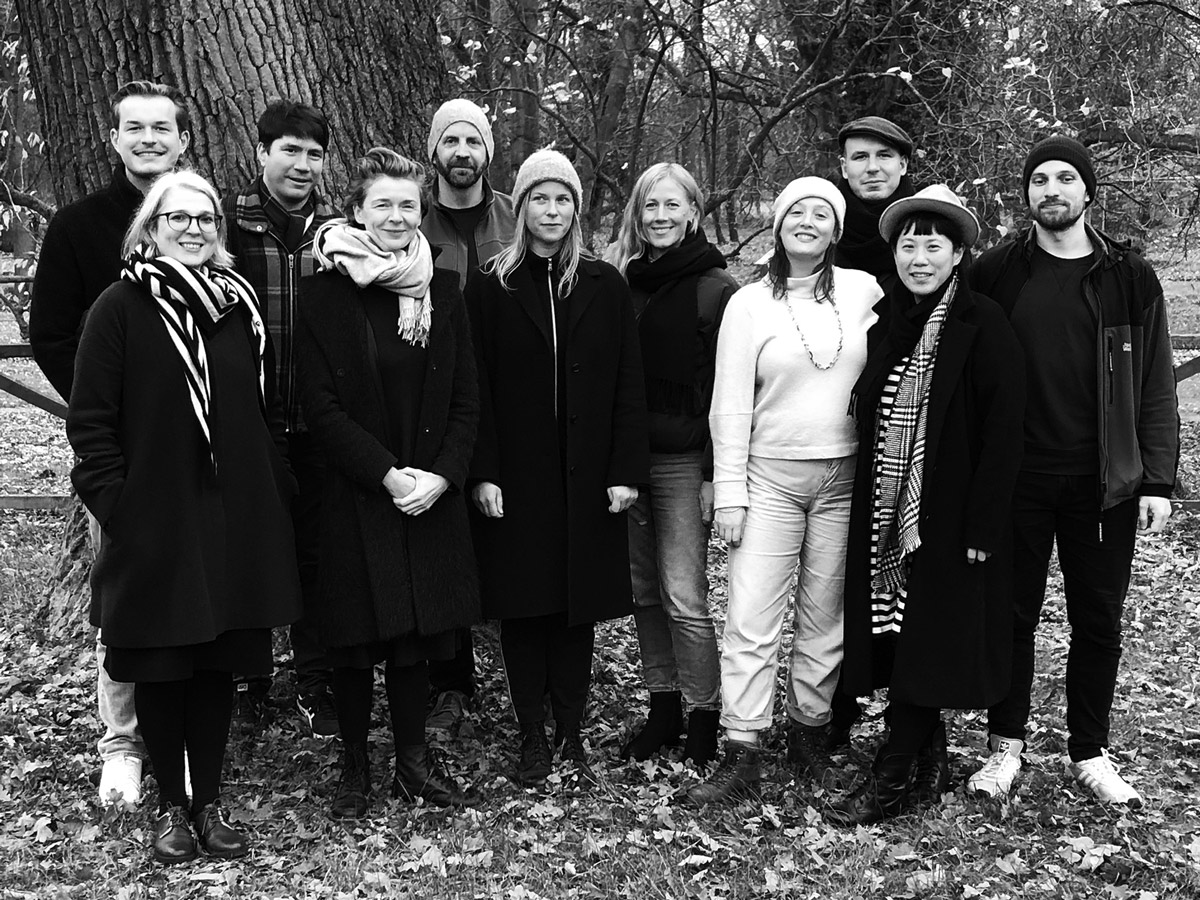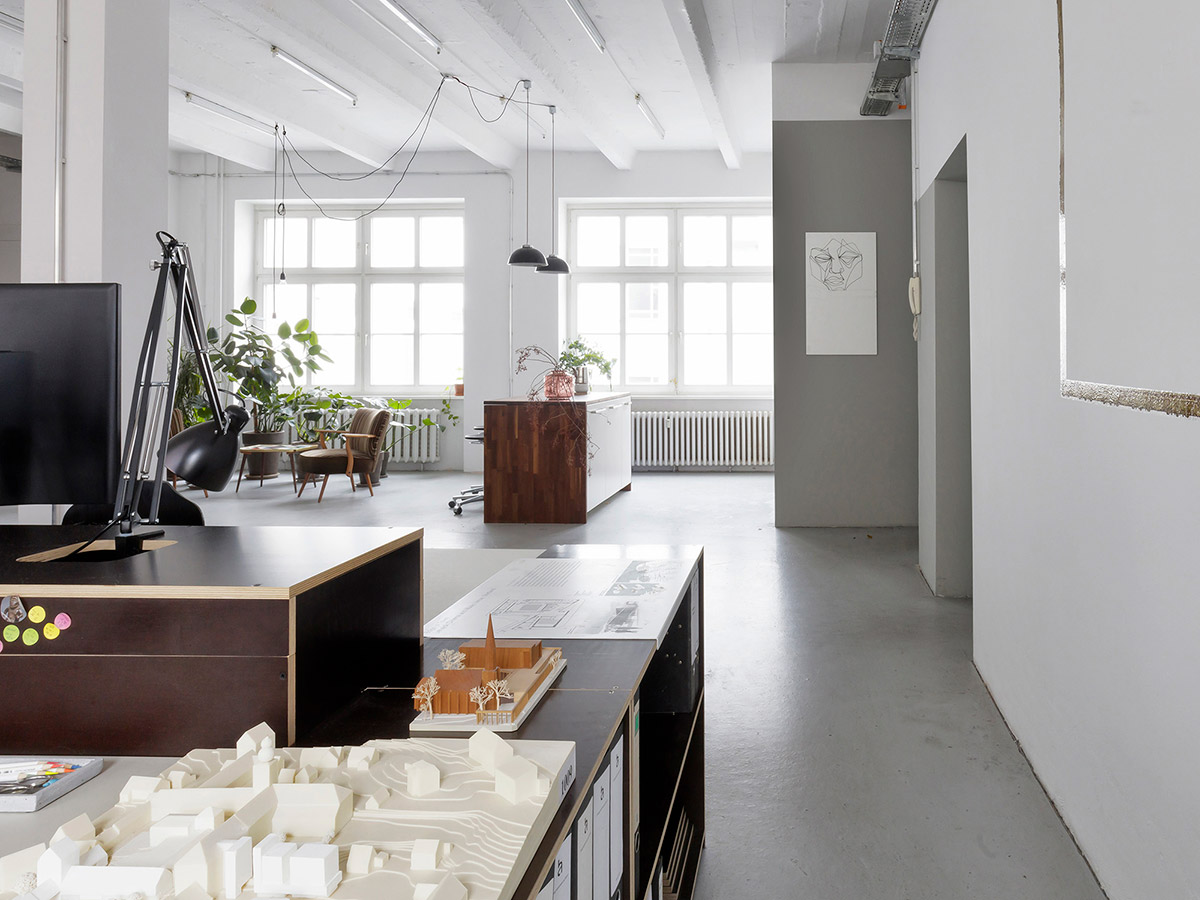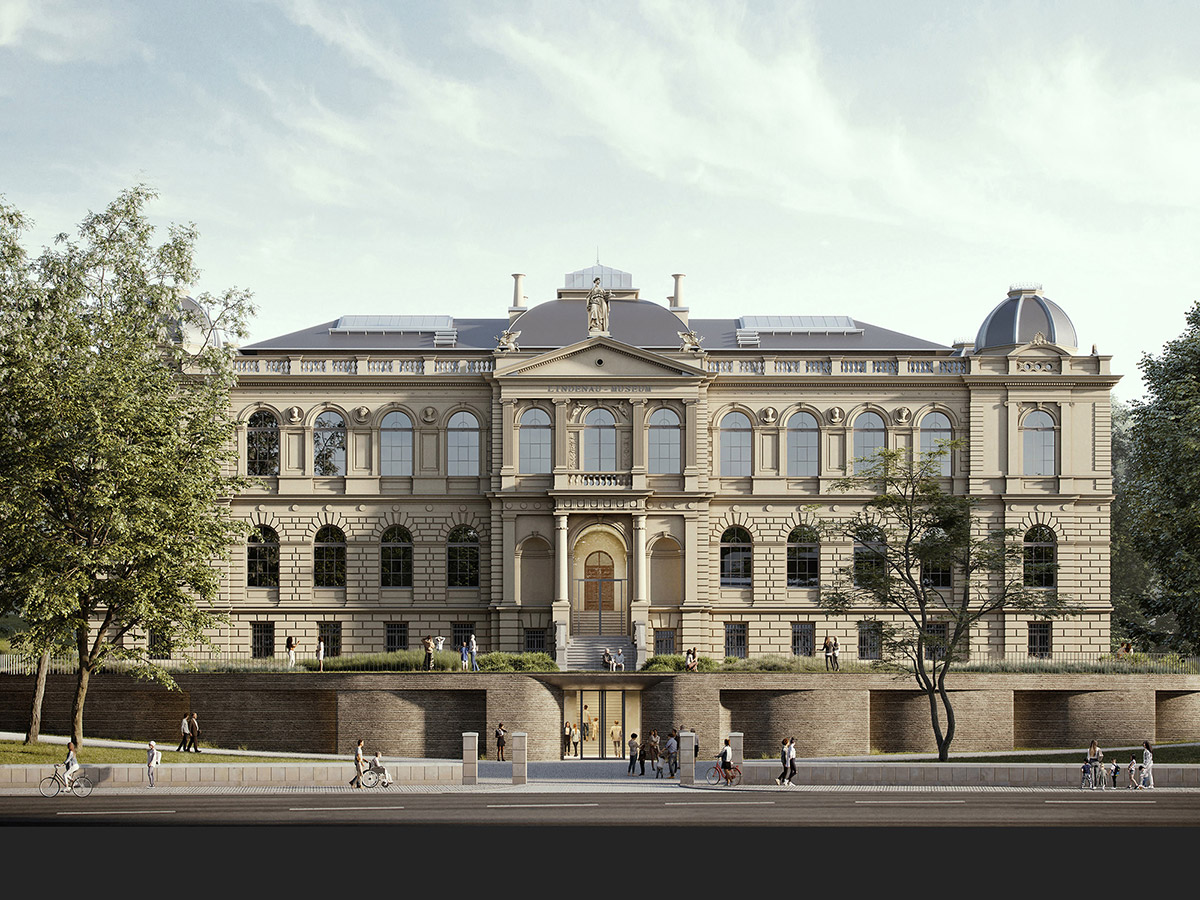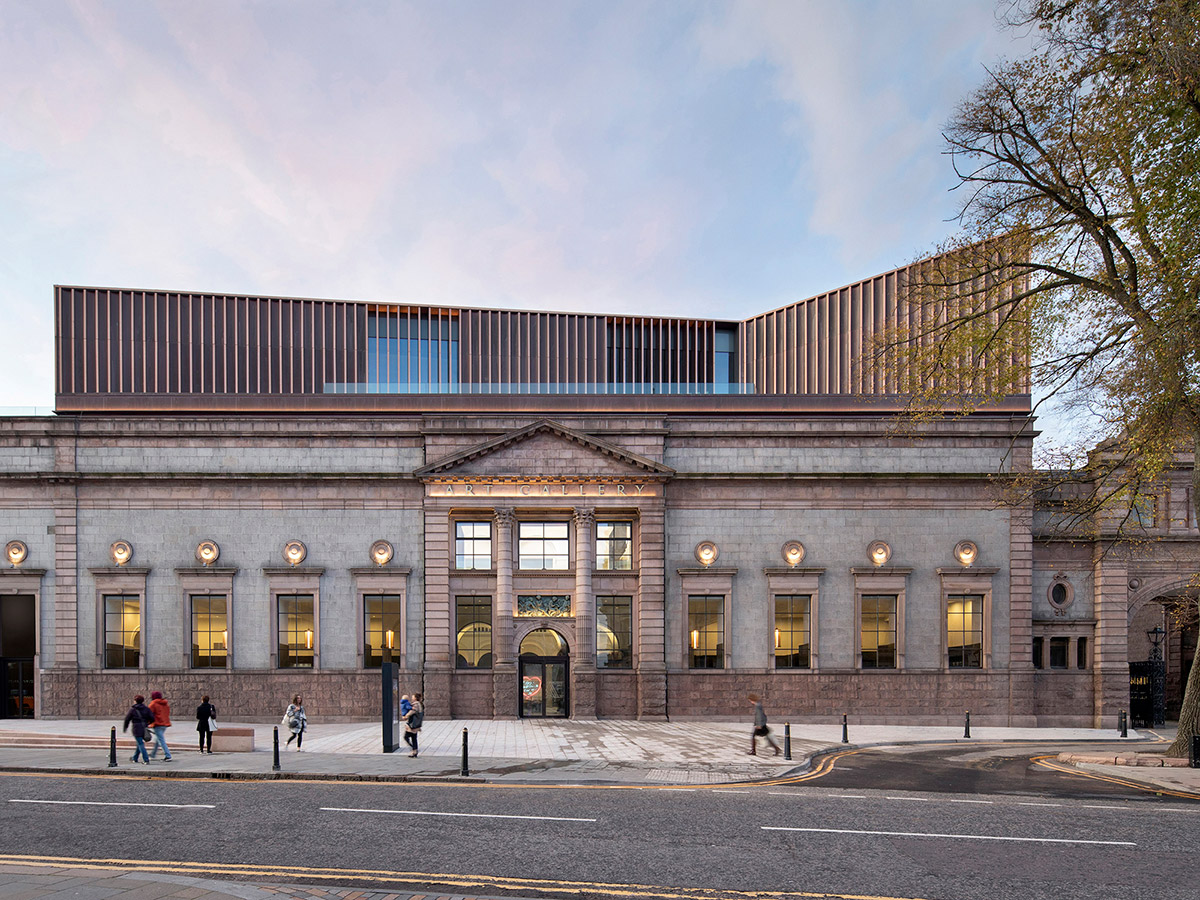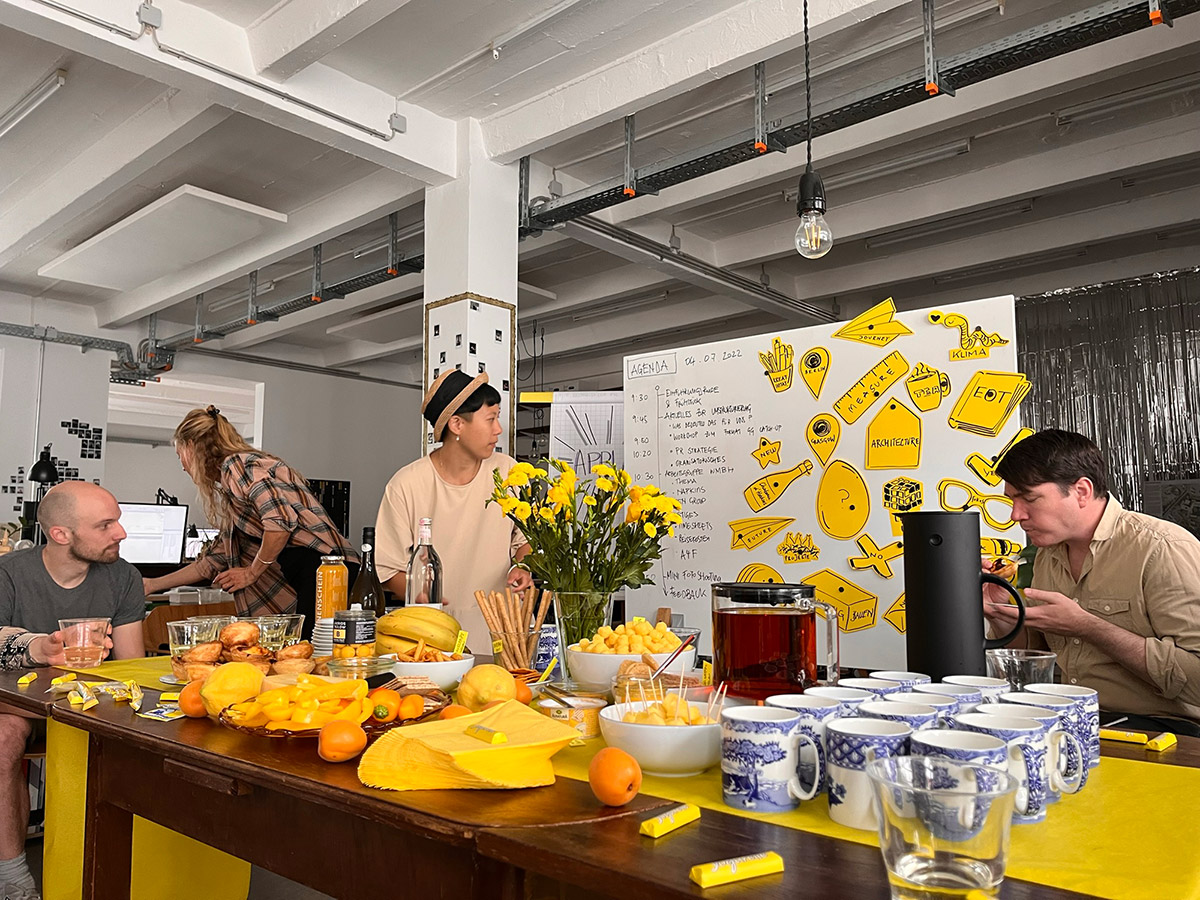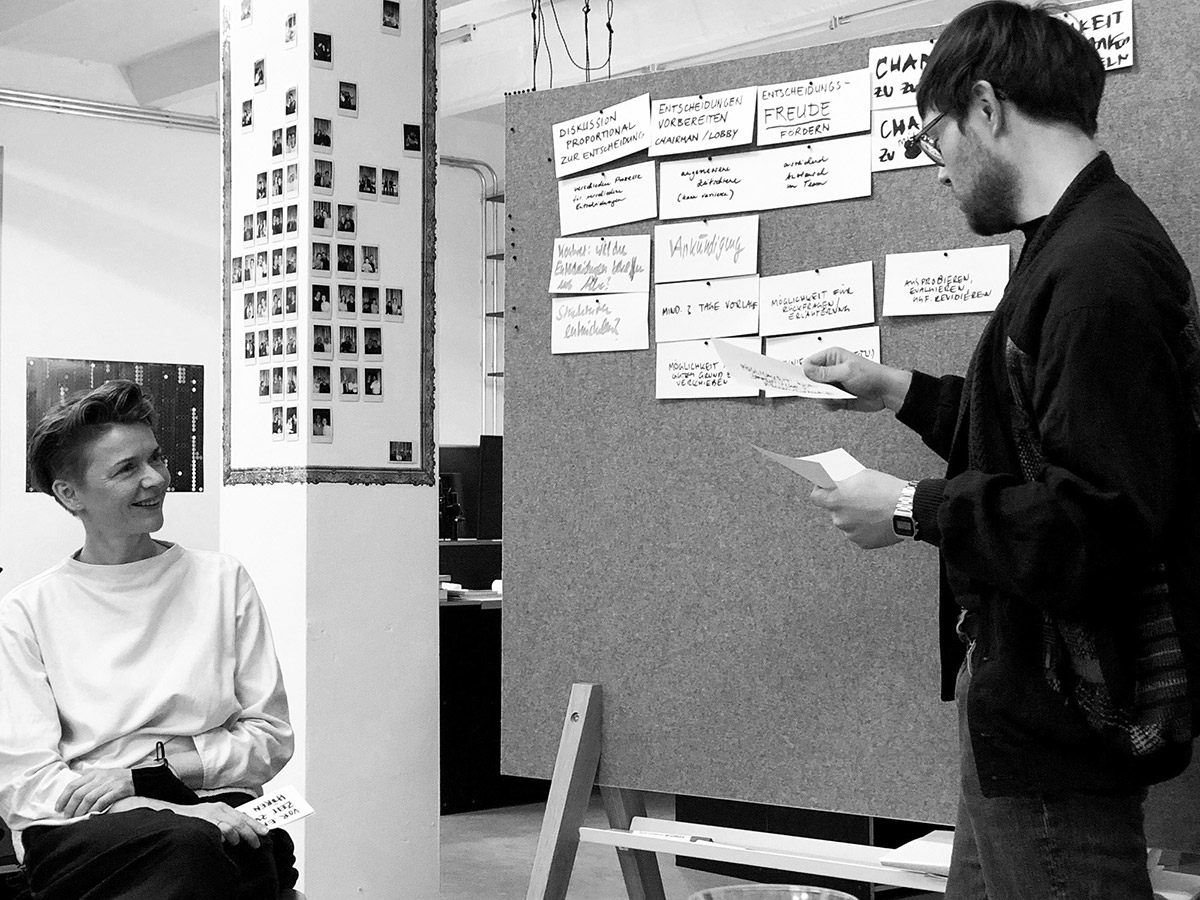Interview
Please, introduce yourself and your office…
Hoskins Architects was established in 1998 by Gareth Hoskins in Glasgow, UK. The practice quickly established a reputation in Scotland for high quality architecture with a focus on cultural, community and health projects. From the outset, Hoskins Architects' philosophy has been 'people focused design', i.e. architecture for people and not for its own sake, with a strong focus on the needs of the client / user / visitor / patient.
Hoskins Architects in Glasgow grew rapidly from a sole practitioner to a firm of around 30 people within its first decade and has maintained this size ever since, becoming a well-established architectural practice in Scotland.
I joined Hoskins Architects in 2001 after completing my master’s degree in architecture in Glasgow. My partner joined the practice two years later and we both worked there as employees for just under 10 years. We decided to move back to our native Germany in 2010, and instead of applying for a position in an architectural practice or starting our own practice from scratch, we worked as freelancers for the Glasgow studio, trying to gain enough traction to set up an office for Hoskins Architects in Berlin.
After three years of smaller commissions and numerous competition entries, we finally won a major commission for a museum project in Vienna in a two-stage open competition, allowing us to formally set up an office in 2014. Over the next ten years, our Berlin office grew to around 15 people.
2016 was a pivotal year for Hoskins Architects. Founder Gareth Hoskins died unexpectedly and prematurely at the age of 48. With no obvious succession plan in place, the company faced an uncertain future. In the same year, the Brexit referendum decided that the UK would leave the European Union, bringing to an end a process of further integration between Germany and the UK. Not a good situation for a small practice just starting to make the move from the UK to Europe.
Over the next five years, the directors of the Glasgow and Berlin offices including the remaining two shareholding directors discussed the future of the two studios and developed several possible models for restructuring our organisation. The model that best matched our vision was to become an employee-owned company. In the UK, the Employee Ownership Trust model, introduced in 2014, provides a great way to ensure company succession by putting the company in the hands of employees without the need to invest individually into the company. Instead, the previous owners are being paid off over a number of years from the company’s profits.
The legal ownership lies in the hand of the Employee Ownership Trust, led by four elected Trustees (two from Glasgow and two from Berlin) and an external Trustee. The beneficial ownership lies with the employees as defined in the Trust Deed. This means that after the previous owners are paid of no further dividends will be paid. All profit earned is reinvested into the company in the form of salaries or equipment or retained as companies reserves. Our Trust Deed allows the payment of staff bonuses from profits only if they are paid out equally amongst employees.
Since 2022 Hoskins Architects is now an employee-owned company, organized in a group structure with two trading companies as wholly owned subsidiaries of Hoskins Architects Group, which in turn is owned by the Employee Ownership Trust. Larger companies such as Arup Engineers or John Lewis Partnership use this model on a much larger scale but as this model is based in the UK and not in Germany we are probably the only German architectural practice organized this way.
A similar, though not identical, model is to be introduced by the current German coalition government under the name "Gesellschaft mit gebundenem Vermögen" (company with tied assets). There are some differences between the two models, but in general the basic ideas behind both models are very similar:
- The principle of self-determination: control of the company is in the hands of people who are committed to the company for the long term.
- The principle of asset retention or asset lock: Company profits are a means to an end and cannot be siphoned off by shareholders.
I have to emphasize that this is not a typical model for an architectural firm in Germany at all. Quite the opposite: the Architects Chamber Act stipulates that an architectural firm needs to be personally owned by its founders and all owners need to be natural persons to be allowed to use the title “architect” in its company name. Alternative ownership models such as cooperatives or current ownership models of companies with tied assets (so-called golden share models) for architecture firms are discriminated against by the Chamber of Architects Act.
How do you remember your time as an architectural employee/worker? What changed when you transitioned from employee to employer?
Having entered the architectural profession some 25 years ago, in the late 1990s, I have seen quite a lot of change over the years, although not as much as you might think, as the transition from hand drawing to CAD was just about complete by 1998. When I started as an employee, I was involved in 3D modelling and Photoshop just as a graduate might still do nowadays. Of course, the software capabilities were not as advanced, but it was similar in principle. I think the biggest changes in the architectural profession are yet to come (and they will not be BIM based, but AI based).
The biggest change I have experienced was the cultural difference between working in Germany and the UK. In my first year of work experience in Germany it seemed normal to me that people (100% men) shouted at each other on building sites and even in meetings. The atmosphere was at times highly toxic. In my 10 years of working in the UK I had never experienced this kind of behavior even once. People were much more polite and gentle in Scotland, and this was true of writing too.
The tendency to be overly polite also brought with it some difficulties. People often tried to avoid difficult issues or situations. There were never any "mistakes" or "errors" made or admitted, only "inaccuracies" and "discrepancies" discovered. German expats in the UK architectural community were often seen as a little blunt, but also refreshingly straightforward in conflict situations. One of the things we wanted to re-import to Germany when we set up the Berlin studio was this appreciative behavior, which is deeply rooted in British culture. But we also wanted to retain the German straightforwardness that had served us so well in the UK. It was probably the combination of both that our clients and staff found new and unique. We were often told that we were different from all the other practices they had worked with and for.
Please describe the working culture and working conditions in your office?
Our Berlin office currently employs 15 people, the Glasgow sister company employs 30 people. The working culture is ever evolving and developing as we create our very own brand of New Work and Holocracy. We recommend listening to the kntxtr podcast “Holokratie und New Work mit Hoskins Architects” if you want to hear more about our approach in much more detail - please note that the podcast is in German, though.
With our open and honest yet polite and appreciative approach described in the previous segment we seem to have created a working culture that comes very close to the culture being described in many publications of New Work without us being conscious about it for a long time. Shortly after we set up the Berlin office we started to invest in the personal development of communication skills through seminars and special literature. My partner has taken a much deeper dive into the realm of communication by gaining additional qualifications in mediation and as a business trainer and is now leading our people and culture unit that continues to develop our role-based approach of organizational governance. The basic principles of communication theory from Schulz von Thun to Marshal Rosenberg are now part of our regular onboarding process.
I would not claim that we have reached the end of our journey of improving working culture and working conditions, but we are constantly investing, interrogating, and trying to improve.
The “hard facts” of our employees (as of end of 2023) are as following: 15 employees plus two student trainees. Proportion of female employees is 58,8%, 23,5% of our staff are non-German native speakers and 35,3% have a migratory background. The average age is 38,2, the average work experience is 11,8 years. The average length of service at the Berlin office is 4,2 years (not including time worked for the Glasgow studio before) and the average salary is currently 4.200 € based on a full time equivalent 37,5 hour per week contract. This average depends greatly from the average experience in our office and this may vary from one year to another. We had the same average in 2018, a lower average (3.900 €) in 2021 and a higher average (4.500 €) in 2022. I was wondering whether it is useful to talk about absolute figures here, also bearing in mind that we live on a volatile economic climate with high inflation rates and those figures may mean very little in a few years. However, as this interview is about working conditions and also about salaries, I would argue that we do have to talk about money as well. For a general comparison: in 2023 the median salary of full-time employees in Germany was around 3.700 €, the median salary of academics was around 4.800 €. I will go into more detail about the salary structures in architecture later.
In 2023 we had a negative gender-pay gap, meaning that women's earnings were higher than those of male members of staff, however due to the small size of the office a single person can make a difference. We can certainly confirm that people with a similar work experience are paid the same wages, independent of gender. Apart from the student trainees who are only allowed to work 20 hours a week most of the staff work full time (37,5 h/week). Only 20% members of staff are working part 80% or 90% part time.
We are currently in a three-month testing phase for a reduction to a 32-hour-week to bring everyone back into full time employment as we believe that this creates more equal career opportunities for everyone and at the same time creates more time for care work, voluntary work, professional development, and time for reflection. The typical working pattern will be 8 hours Monday to Thursday but can be adjusted individually to suit. This trial is scheduled for three months with the aim to stick with a 4-day-week long term, if possible.
Since we are a small business in an industry that is not known for being overly profitable, we are not able to do this trial at 100% salary. For the three-month period the salary is reduced to 85%. If the trial is successful and we manage the workload without having to put in extra hours we will try to gradually increase the salary to the previous level or alternatively gradually reduce the hours from 37,5 to 32 hours per week with full pay.
The precondition for reducing working hours is that there is no current need for overtime. We have just finished an analysis of our working hours from ten years’ worth of time sheets and have pretty accurate figures of actual worked hours. We have managed to gradually reduce overtime from year to year and are now at an average of approx. 5% (of 37,5 h) or 2 hours per week which we would consider as an acceptable average compared to the average in the industry as surveyed in 2022, where the average contracted hours for employed architects in Germany are 40,1 hours and the average overtime is 13% or 5,4 hours per week.
About 70% of the employed registered architects in this survey are getting their overtime refunded, mostly as time off in lieu. However, even with this percentage deducted the average full time employed architect in Germany works 41,7 hours per week, therefore we are doing reasonably well in our office in terms of average working hours.
The figures are derived from the most recent survey of employed Architects by the German Federal Chamber of Architects (Bundesarchitektenkammer (BAK)) from 2022, which gives a very detailed picture of the state of the current working conditions in German architect’s practices: working hours, overtime, part-time, salaries etc. It is worth noting, however, that only registered architects are surveyed, and they often represent less than half of the workforce in an architectural practice, and probably the better paid half, as many employees not registered as architects are graduates, younger employees and architectural workers from abroad. It is also worth noting that the average self-employed architect in Germany works 50 hours per week. About 70% of those self-employed architects are sole traders or work in very small offices with less than 5 people.
In 2022 the average employed registered architect in an office of 10-19 people had a median salary of 4.300 €/month based on a 40-hour/week contract with an average of 28 days holidays. If we compare our working hours, holidays and remuneration to the surveyed national average of registered architects working we do pay above average, but not substantially.
In a city with ever increasing rental prices like Berlin this may feel not enough for younger people joining the office, but the salaries we can pay relate directly to the level of architectural fees our (almost exclusively public) clients are prepared to pay.
Salaries – According to you what are fair salaries?
This is a very important question, but one that is rarely answered conclusively or honestly. Firstly, we need to consider whether architectural practices in general are paid a fair fee for the work and services they provide; secondly, we need to consider what happens to the profits made by the firm; and finally, whether the portion used for salaries is fairly distributed among the people who contribute to the collective effort and body of work within the architectural practice.
Are architectural practices in general paid fairly? For a long time, the mandatory fee scale of the German HOAI had provided a relatively strict framework of architectural fees for basic services. The European Court of Justice ruling from 2019 has required Germany to abolish the mandatory minimum and maximum rates for reasons that I believe are questionable, but I would not like to go into in this context. Having worked in the UK and in Austria, where mandatory fee scales were abolished much longer ago (1987 in the UK and 2006 in Austria) I do have firsthand experience about the pressure on fees that these countries have experienced and how the quality of service can be affected. The long-term impact of the ECJ ruling on the German architectural market is not yet fully foreseeable.
In theory, architectural fees should now be able to move in both directions, but the expectation of clients is that fees will be reduced. This is not compatible with clients' increasing expectations of the coordinating role of the architect in the planning and construction process, which requires highly professional communication and mediation skills and which I would describe as “the architect's unpaid care” work. The profitability of architectural practice is likely to be reduced in the long term, and the UK is a good (or rather bad) example of the effects of this race to the bottom.
The second question is in the hands of the owners of the architecture firm: what happens to the profits? Even with lower architectural fees, the owners could still make a large profit for themselves by exploiting their workforce or outsourcing certain services to low-wage countries.
I am sure that the vast majority of owner-managed architectural practices have responsible owners, and many of these owners have put a lot of time and effort into their businesses and may have suffered financial hardship in times of crisis. At some point, however, the distinction between founders and employees can become a thorny issue, particularly in relation to profit-sharing rights. We see our employee ownership model as part of a wider movement towards a fairer and more sustainable economic structure and we identify ourselves as part of the steward-ownership movement by putting purpose over profit.
Stewardship ownership ensures that profits serve purpose - all profits are reinvested in the business rather than paid out as dividends. This ownership model is at odds with Friedman's doctrine of shareholder value and capitalism in general. But there is ample evidence that employee-owned or steward-owned companies are more durable than conventionally owned companies. “Compared to conventionally owned companies, steward-owned companies also pay employees higher wages with better benefits, attract and retain talent more effectively, and are less likely to reduce staff during financial downturns.” (From “Steward-Ownership, Rethinking ownership in the 21st century” by the Purpose Foundation)
For further reading on the principles of steward-ownership we recommend the recent publications of the Purpose Foundation on their website purpose-economy.org .
Once the business is structured in such a way that no dividends are paid to shareholders, we have a situation where all profits are reinvested in the business, either in the form of staff salaries, equipment, or capital reserves.
The distribution of salaries amongst the different grade of staff is the third and last step to achieve fair salaries in our sector. The most common measurements are the pay-ratio (Gehaltsspreizung) between highest and lowest earner, the ratio between the highest individual salary and the minimum wage or the ratio between the highest individual salary and the average salary in the company or the average national salary. The median average is often preferred to the arithmetic average when looking at the national average as it is less skewed by excessive CEO salaries, therefore I will only refer to median salaries.
Income inequality is a tremendous problem in today’s economy since high levels of income inequality are linked to economic instability, financial crisis, debt and inflation. The ratios common in large companies are obscene: CEOs of the UK FTSE 100 companies earned on average about 120 times that of the median UK full-time worker in 2022, up from abpout 80 times in 2020. In Germany the pay-ratios are not as extreme, but still enormous. The average CEO of a DAX company earned about 40 times the national median salary in 2022.
The pay gap is less pronounced in architecture, mainly because the companies are much smaller and there is simply much less money to be distributed and accumulated at the top. Nevertheless: the imbalance between the amount of profit an owner can extract and the salary of the employees who mainly generate this profit can create a great sense of injustice.
The median income of an employed registered architect in 2021 was 53.000 €/year. The median profit per owner of an architectural practice of 10 staff or more in 2021 was 180.000 € per year. The arithmetic average of profit per owner was 245.000 €, indicating that there may be some owners who make very large profits, that could be up to 10 times the median salary of an employed architect and some of the highest earners may not have disclosed their income at all. Architecture firms are worlds apart from the pay inequality of large-scale companies, but the pay ratio between top and lowest earner can still be substantial and problematic.
To understand what salaries are genuinely considered “fair” it is worth looking at pay ratios recommended by the Economy for the Common Good (ECG) movement (in Germany: Gemeinwohl-Ökonomie (GWÖ).
In its handbook and matrix , the ECG/GWÖ considers a ratio of 1:20 or more to be prohibitive, and a ratio of 1:5 or less to be advanced. In earlier iterations of the matrix, the ratio was described more specifically in relation to company size. For a company with up to 20 employees, a ratio of 1:3 or less was considered exemplary.
The GWÖ-Matrix also calls for an adequate living wage based on the individual location of the company. The living wage is not to be conflated with the minimum wage (currently 12,41 €/h gross in Germany) but adjusted to reflect regional cost of living and adequate social participation. Ideally though, the minimum wage should also be a living wage. In Germany, the minimum wage has been increased by 30% between 2021 and 2024 to approximate a living wage, but local and individual factors are not sufficiently taken into account.
To return to the question: "What are fair salaries?" I would argue that a prerequisite for fair pay is a system in which everyone is paid according to their actual contribution to the business, not according to a share of the profits based on ownership. This system is easier to implement in a company with tied assets or in an employee ownership model, but in principle it can also be implemented in a traditional ownership structure by foregoing profit distributions or limit profit distribution to the level of an appropriate salary. My own proposal for a fair salary structure in a medium-sized architecture firm (10-50 employees) would be a structure in which the ratio between entry level and highest salary is 1:3 or less and the ratio between minimum wage and highest salary is 1:5 or less. The individual salaries need to be determined according to the individual contribution to the success of the company and the individual needs of the employee within these parameters. Our own salary structure has even lower ratios than this and we are working towards making the structure fully transparent. The US firm Buffer, known for being 100% transparent about their salaries for over 10 years now have simplified their approach to the following formula: “your role x your cost of living = your salary”. Transparency is an incredibly powerful tool and not talking about money only helps those who tend to have too much of it.
What needs to change in order for the architecture field to have better working conditions/salaries?
As discussed in the previous segment there are three elements that need to be addressed: fair fees for the services architects provide, fair ownership structures and fair salary structures within architectural offices.
The mandatory fee scale provided a very strict system that was not always fair but reliable. The abolishment of minimum and maximum limits of fees by the ECJ ruling in 2019 is likely to have a negative impact on fees and on design quality – my experience from working in the UK does support this view. I see it as one of the primary tasks of the federal chamber of architects (BAK) and the individual chamber of architects of the federal states to lobby for a continuation of the fee scale as the main orientation for clients (public and private) but also to lobby for a new fee scale for work within existing buildings, which will be the primary task for architects in the future and for services that are not included as basic services in the HOAI but will become the focus of our field of work. The current fee scale (HOAI) is too much focused on new built and does not adequately address the requirements for reuse of buildings or the increasing complexity of the interaction of stakeholders.
Regarding the call for a collective labor agreement it is worth noting that there is an existing agreement between the employers' association ASIA (self-employed engineers and architects) and the trade union ver.di (United Services Trade Union) since 1980. However, there is no widespread use of this agreement and the salary levels and conditions contained therein are not freely available. From the little information that is available online it seems that there has been no binding agreement achieved in 2023.
There are other employers' associations publishing non-binding salary recommendation (ADAI, IAP). Whilst those salary recommendations are not negotiated with a trade union at least they are transparent and freely available. These salary recommendations can provide orientation and, together with the biennial survey conducted by the survey by the Federal Chamber of Architects (BAK), they provide a good picture of the status quo of salaries in architecture in Germany.
It is fair to say that the trade union movement of architects currently leads a shadowy existence in Germany. Within the 2 million members of ver.di, architects are not a large enough group to have any real influence. Architects could also join IG Bau, which has 220,000 members. However, they are also a very small group within this union and do not have any specific employers' association to negotiate with. About 15 years ago, there were attempts to build a movement with the long-term goal of a trade union for architects in Germany, starting with an online database of offices and reported working conditions (very similar to what kntxtr maps is trying to do today). The movement received some media attention in Baunetz and DBZ (Deutsche Bauzeitung) in 2010, but the organisation and website (arcvote) appear to be long defunct.
The debate about unionisation in architecture has received much more international attention in the last two years with the case of the small Brooklyn-based firm Bernheimer Architects, which became the first private sector architectural firm in the United States to join a union in 80 years. The case has attracted particular media attention because unionisation drives at two larger firms (SHop Architects and Snøhetta) supported by the AWU (Architectural Workers United) have been unsuccessful, and the way in which the unionisation campaign was apparently curbed by specialist lawyers has been heavily criticised. Working conditions, particularly long hours for low pay, are deeply problematic in architecture. They have been problematic for as long as I can remember, and from the perspective of the 1990s it could be argued that the situation has at least improved in the last 30 years.
One of the main problems we face is the cavalier attitude of architects towards time and resources. This attitude also exists on the client side towards the architect and is then projected onto the staff within the practice. There is an underlying assumption that time is less valuable if you are passionate about what you are doing. The architectural competition system, with its abundance of abortive, futile work, is a deep-rooted problem that needs to be addressed to avoid the need for unpaid overtime. The glorification of self-exploitation for the greater good of design must end, without compromising the quality of architectural output.
Should Salaries be part of the job description?
It is currently not common in Germany to advertise the salary in the job ad for architects, but this also leads to huge differences in expectations, especially for entry-level architects. In the last two years we have seen a wide range of salary expectations among graduates, from just above the minimum wage to over €4,000 per month. According to the BAK survey, starting salaries range from €2,800 for graduates with a bachelor's degrees to €3,200 for graduates with master's degrees. The 2024 salary scale recommendation by ADAI is calling for 3.500-3.600 €/month for T4 (master's degree). These salaries seem totally justified in terms of the length of education and cost of living, especially in cities like Berlin. They are not necessarily reflected in the fees we receive for our projects and therefore currently very difficult to be paid.
Salaries within the office should be transparent, especially in an employee-owned company like ours. I also believe that this drive for transparency requires something in return from each team member: financial literacy and a good understanding of market conditions and the various factors that determine a fair salary distribution. We are currently working on a salary matrix that will take into account the factors we believe should be considered: roles and responsibilities within the team, experience and value to the practice, as well as certain personal circumstances where these are not adequately covered by the statutory regulations.
If we manage to find a transparent model for our salaries within our team (which we are working on) it would make it easier to communicate this to applicants even before an interview and avoid disappointment.
What are your thoughts on UNIONIZING? Do we need an Architekt*innengewerkschaft in Germany?
Trade unionism was, and still is, necessary to organise workers against profit-driven employers to fight for better working conditions and fair pay. It may be the only way to defend workers' rights against large corporations. This may be appropriate where architectural firms are, or become, part of larger conglomerates. However, I am not sure that unionisation is the way forward for an employee-owned company, where people should have the direct means to improve their own working conditions and pay, as this is a completely different approach to securing workers' rights.
It is important to note that not every company that calls itself employee-owned gives its workers a proper say in the organisation of working conditions and pay. There are big differences in the way these organisations are run.
In my ideal world, employee-owned companies do not need to be unionised because they would have a say in profit-sharing, wages and working conditions and working hours, i.e. all the elements that a union negotiates with employers. Only if these conditions are not met in an employee-owned company, I would support unionisation.
Quick Questions – What is your take on:
Gen-Z-Working-Mentality: I wouldn't dare say that I can judge the work ethic of an entire generation from my own small perspective. I suspect that the willingness to be exploited has diminished over the years, which is a good thing
4-Day Workweek: - We are currently trialling a 32-hour week model, which can be worked over 4 or 5 days as required. The aim is to ideally allows all our staff to work 'full time' and that people who have caring responsibilities or volunteer commitments, are not disadvantaged in their careers. If the great economist John Maynard Keynes predicted in 1930 that by 2030 we would only need to work 15 hours a week, then trying a 4-day -week in 2024 should not be seen as revolutionary and is the least we can do.
Fachkräftemangel (lack of skilled workers): Architecture is still a profession with an overall positive image. But working conditions, long hours and low pay are disillusioning and are driving people out of the profession. We will be forced to address the needs of young parents, especially mothers, to keep them in full-time employment and in the profession of architecture as a whole. Defining a 4-day-week as full-time should help to allow more people to find a fulfilling career rather than being sidelined for working part-time. We believe that this is the untapped potential for our profession. It is certainly not the case that we can address the lack of skilled workers by asking people to go back to a 48-hour week.
AI: At best, the use of AI should save time in the design process, e.g. by reducing the effort required for multiple design iterations and allow us to focus on interacting with the (human) project stakeholders. This technological shift could lead to a new focus on the skill sets required by architects, especially better communication and mediation skills. There is also a worst-case scenario that renders the architect superfluous as a creative force, but I'd like to remain optimistic and broaden my view of what creativity really is.
Holacracy: Whilst we are not experts in holocracy we have taken many elements of this approach into our office management structure. We are currently working intensively on the roles in the system (name, purpose, levels of control and accountability) and defining the process of stepping in and out of those defined roles. We do not however follow the strict guidelines of the holocracy constitution.
New Work: The topic of New Work would require its own interview and cannot be summed up in a short answer. I would compare the pros and cons of using this very broad term with the term sustainability. New Work has a specific origin and meaning and has a revolutionary core, but it is also susceptible to misinterpretation, dilution, reduction to a marketing tool and is sometimes misunderstood by architects and clients as a spatial concept. I assume that "new work washing" will become as widespread as "green washing" is today. Listen to the podcast if you want to hear more about our approach.
New Business Model in Architecture: With our own model of employee ownership we feel we have already created a different business model that may be common in the UK but is not common in Germany. We are keen to see the proposed "Gesellschaft mit gebundenem Vermögen" (company with tied assets) coming to live and would be very interested in this model if we hadn’t already transformed our business model. We are also interested in the cooperative approach, although we have not found this model to be very widespread in architecture. The recognition of these business models by the Architectural Chambers needs to be improved and the Architectural Chambers Act needs to be adapted so that the title "architect" can be used by those models that have at their core the idea that the architectural practice is owned and controlled by its employees.
Image Credits: © Hoskins Architects © Gillian Hayes
Publication Date: 03/2024
Website: www.hoskinsarchitects.com
Instagram: @hoskins_arch
LinkedIn: @hoskinsarchitects
